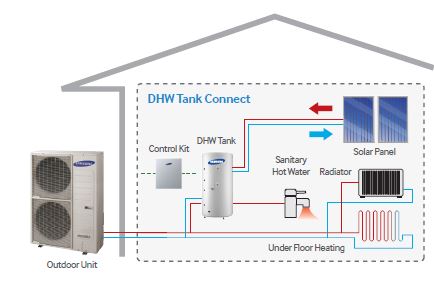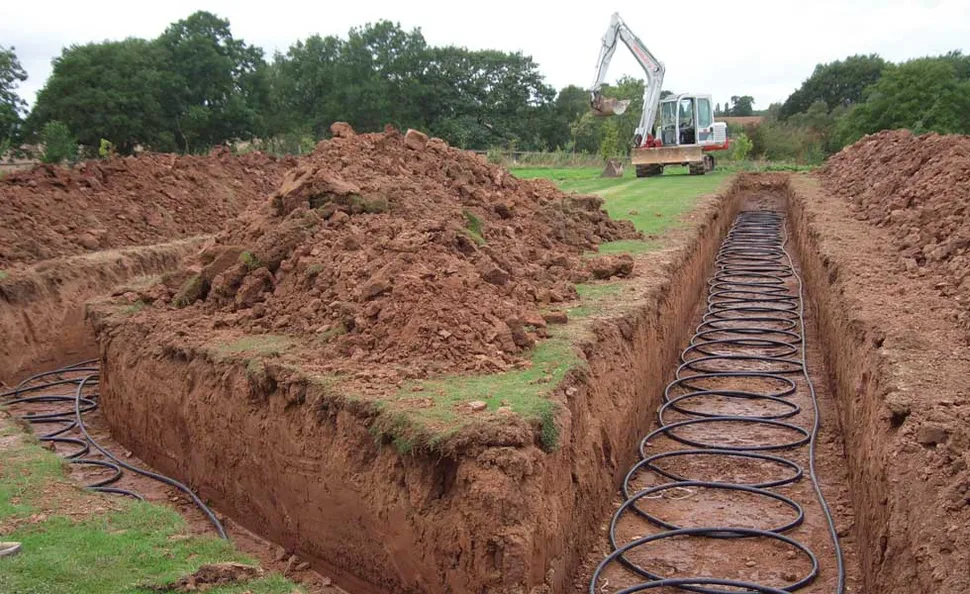
Never buy a Gas boiler again, get an air or ground source Heat Pump instead.
Did you know, in the UK Household emissions from heating and hot water must (by legal commitment) be reduce by 95% to reach the 2050 net zero targets.
Thats a big target, it means reducing heating emissions to 138 kg CO2 per household and we simply can’t reduce carbon emissions from our central heating systems sufficiently, if we continue to use natural gas or oil to heat our homes.
so what are the alternative options?

So what are the alternatives and how do they work?
Heat Pumps are one of the alternative options, and where better to start reducing your heating / energy costs and reaching those CO2 targets, than by replacing old gas and oil burners with newer, more efficient heating systems that replace the need to burn fossil fuels altogether.
Heat pumps are quite simple yet exceptionally clever devices, that take warmth from outside sources (Air or Ground) and then use that heat to warm our homes.
For the benefit of this article, i’ll be covering the use of Heat Pumps within the UK, as this is the region i’m most aware of. That said, a lot of the information provided in this post is still very relevant wherever you are in the world.
Similar Government grant schemes are also being adopted around the world as countries sign up to the same targets.
Lets start by covering what types Heat Pumps there are first.
At the time of writing this article there are Three types of Heat Pumps. Two Air Source Heat Pumps that take warmth from the air and One Ground Source Heat Pump that takes warmth from the ground.
All of these pumps use electricity to work, so you’ll benefit even further if you produce your own electricity with Solar, Wind or Hydroelectric sources.
Heat Pumps also work much more efficiently at lower temperatures than standard boiler systems, so they’re perfect for underfloor heating systems and systems with large radiators.

Air Source Heat Pumps (ASHP’s)
To work, Air source heat pumps need to be fitted to an outside wall, preferably on a sunny side of the building and connected to your electricity supply to power the pump.
There are currently two types of Air Source Heat Pump, Air to Air and Air to Water, with the latter the most common in the UK.

Air to Air – Air Source Heat Pumps (Air to Air ASHP)
Air-to-Air heat pumps work in a similar way to Air-to-Water pumps, however as their name suggests, they output warmed air instead of warmed water.
This means instead of using your existing radiator based heating system, Air to Air systems require a warm air circulation heating system (See image above) to move the warmed air around your home. This type of heat pump is more likely to be used in countries around the world that already use this type of warm air heating system.
Air to Air heat pumps are also less popular in the UK because unlike the other systems listed on this page, they don’t provide hot water for your property.

Air to Water – Air Source Heat Pumps (ASHP’s)
Air to Water ASHP’s are the most common heat pumps in the UK because they absorb heat from outside air and transfer that heat into water. This water is then used to heat your home and your hot water system, which means they can be fitted directly to your existing wet central heating system. This makes Air to Water Heat Pumps great replacements for older Gas / Oil boiler systems.
ASHP’s are also popular because they provide a nicer internal environment temperature. Unlike older boiler systems that are constantly turning on and off, creating constant shifts in inside temperatures, ASHP’s generate heat at lower temperatures over longer periods of time warming spaces constantly and providing a warm constant heat.
So ASHP’s are great alternatives to existing boiler systems, and because the heat they generate is greater than the electricity used, they’re a very very energy efficient method of heating your home.

Ground Source Heat Pumps (GSHPs)
Ground Source Heat Pumps are very similar to Air Source Heat Pumps however as their name suggests they get their heat from the ground instead of the air.
In a domestic setting, Ground Source Heat Pumps (GSHPs) use pipes that are buried in the land around your property (See picture above). The length of the ground loop depends on the size of your home and the amount of heat you need. The longer the loops the more they can draw heat from the ground, but of course this requires more space to be buried in. If space is limited, a deeper vertical borehole can be drilled instead.
A mixture of water and anti-freeze is pumped around the pipes in the ground (AKA Ground Loop) and absorbs the naturally occurring heat stored in there. The ground stays at a fairly constant temperature under the surface, which is perfect for ground source heat pumps and means they can be used throughout the year.
GSHPs can also increase the temperature from the ground to around 50°C, although its worth remembering the hotter you heat the water, the more electricity you’ll use.
The warmed water mixture is then compressed and goes through a heat exchanger, which extracts the heat and transfers it into the heat pump. The heat is then transferred to your home heating system, heating radiators, underfloor heating pipes and hot water in your home. It can also be used with warm air heating systems, although this involves additional Heat Exchangers to be installed.
Cost Comparisons – Heat Pumps v Conventional Central Heating Systems
GAS Central Heating
Gas systems vary in price wildly depending on how much work is required, the parts needed, their availability, where you live, who you ask to quote and what type of boiler you want.
The higher costs seem to be linked to those who receive quotes from their energy company, while lower quotes could be from a smaller traders.
Either way the type / make of boiler will affect costs widely too.
To give you a better idea, a Recent WHICH investigation (10th Nov 2020) highlighted these price variances when they had a boiler expert arrange for 10 quotes to replace his own boiler.
During his investigation, requested quotes varied widely and came in between £1500.00 and £5000.00 for the same requested work. (see below)
To be clear, all 10 of the quotes received were for the same old non-condensing regular boiler to be replaced with a modern condensing boiler. Each of the quotes also included the installation of 10 thermostatic radiator valves, a full chemical powerflush, system balancing, MagnaClean filter, a new circulation pump and a new hot water cylinder thermostat.
When doing these calculations for yourself, you should also factor in your current yearly energy bills as these will be additional, ongoing and ever increasing costs, should you stick with fossil fuels for heating.
This is an important factor when deciding how to heat your home moving forward, in 2004, the average home paid just £277 for gas and £288 for electricity, that was a total energy bill of £565 Per Annum.
Fast-forward a decade and this final figure had almost tripled to £1,344 Per Annum!
Even removing the inflation, this is still an 88% increase and prices over the period continue to rise year on year as we import more and more of our gas needs from abroad driving prices higher and higher as we do.
SIDENOTE: These statements are based around figures and information available prior to BREXIT and could be considerably different as import prices on fuel and products look to increase in 2021 onwards.
So when you add £600 – £1000 per year (Possibly more post BREXIT) in additional fuel costs, how is that cheaper upfront payment for a gas central heating system starting to look?
As we find ourselves in an ever increasingly unstable future, self sufficient renewable power and heat looks more and more attractive for the longer term.
Air Source Pump & Ground Source Pump Heating
When you’re choosing an Air Source Pump or Ground Source Pump, it’s worth noting that your initial outlay will look higher than a standard boiler system, but it’s also worth noting that your ongoing costs and maintenance costs are minimal.
It’s also worth mentioning that there are grants out there to encourage home owners to make the switch too.
A typical ASHP system costs around £9,000 – £11,000 and a GSHP around £10,000 – £18,000. Running costs will vary depending on the size of your home, how insulated your property is, and the room temperatures you are aiming to achieve.
But if you’re looking at the figures, financial savings for those replacing an older boiler with an ASHP are reportedly between £400 and £1300 Per Annum with GSHPs between £500 and £1500 Per Annum. These figures were dependent on the type of replaced boiler (Gas, Oil, LPG ) the systems being replaced and type of Heat Pump system purchased.
So when you look closer, the costs are pretty similar. The differences are simple, the longer you have your ASHP or GSHP system the cheaper it becomes and the savings start straight away. The longer you have a Gas or Oil system the more expensive it becomes as import prices are forecasted to increase yearly.
Obviously the financials are very important, but let’s not forget another hugely important factor, LESS CO2! In fact, installing ASHP’s is reported to reduce your CO2 outputs between 4500 and 10500 kg/year less too.
Just Imagine if every home was switched to a Heat Pump system.
I hope you found this article useful, if you live outside of the UK and found more information on grants for your region, please add the info in our comments below.
To view similar articles on our Instinctively Pure Blog click here
Source articles (Links on this page are not endorsements)
Heat Pumps, Boiler costs, Energy Costs , Heat Pumps, GSHP
Main Article Image source




